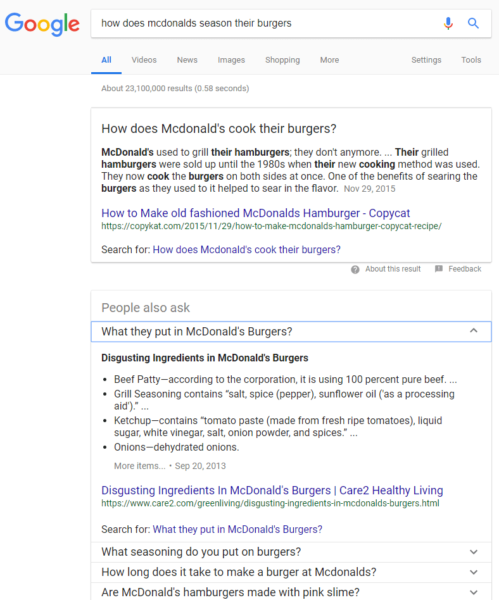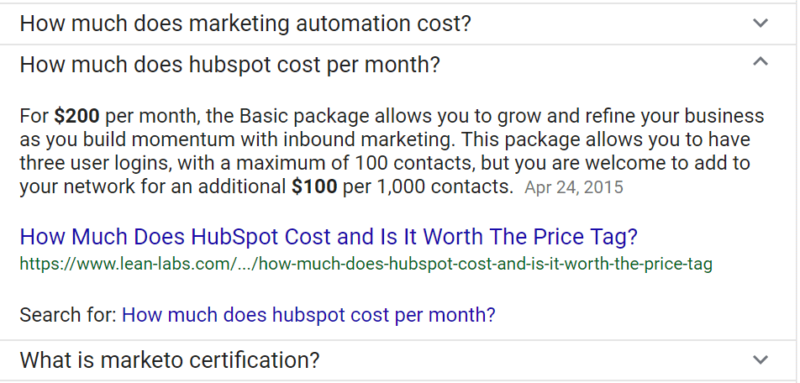The explosion of PAA: Answering questions is the new way to dominate search
Quality answers in plain language land in Google’s answer box and “People Also Ask.” Here's how you can improve your website’s chances as a featured snippet.
A number one organic ranking in search results isn’t what it used to be. In the olden days of 2014, a number one search ranking meant you’d get about 31 percent of clicks in that SERP (search engine results page).
The returns on top organic rankings have been steadily diminishing as Google adds more elements to the SERPs. This was traditionally caused by Google’s attempts to squeeze as many paid ads into SERPs as possible.
In the past year, in addition to AdWords, increasing amounts of SERP space are being taken up by elements like knowledge panels, local packs and featured snippets. In fact, for non-branded search, the average CTR for the first position is now 19.30 percent.
The rise of related questions
The answer box was Google’s most noticeable attempt to provide a definitive answer to queries. Unfortunately, this prime real estate was only limited to one answer. Google began to remedy this with the “People Also Ask” snippet (PAA), which allowed for variations in answers to the question and for searchers to see related queries.
In the past year, PAA has started dominating SERPs and had become almost ubiquitous by year’s end. This featured snippet became very prominent in July, 2018, when PAA started appearing in more than 40 percent of SERPs. When I last checked, according to MOZ, related questions/PAA are now appearing in 79 percent of SERPs.
Due to the ever-expanding, accordion-like nature of PAA, organic search results may be pushed infinitely down the page. The good news, however, is that the answer box has lost some of its exclusivity. Now, there are many chances to get a featured snippet for your site instead of one almighty answer box.
The importance of PAA and the answer box become even greater when noting that by 2020 over 70 million U.S. households are expected to have a voice assistant like Amazon Alexa or Google Home. Google Home uses snippets (along with structured data and knowledge graphs) to answer user questions.
How to create content that lands in the answer box
There are now many more opportunities to get your websites into featured snippets. However, you still have to create content that has a good chance of becoming a featured snippet. Here are some tips for creating content that lands in PAA or the answer box:
- Write complete questions and answers. Make sure that each question is asked and answered fully.
- Use plain language
- Avoid sales language
- Add Q&A schema.
Quality answers in plain language land in Google’s answer box and “People Also Ask”
In short, create quality content that clearly answers questions about your topic or service. This means answering questions in short, plain language or in easily-digestible bulleted lists. This is not the place to push a sales message. For example, McDonald’s can’t resist plugging advertising language into their FAQs.
By opting not to use straightforward language in their response, McDonald’s is opening the door to other websites defining them in the answer box and the PAA, as seen in these examples.
This is also a warning to brands – especially B2B businesses – that shy away from answering questions about your business costs and terms online. If you don’t answer these questions clearly, someone else will.
If your website’s answer to “How much does your service cost?” is “Call us now for a free quote”, you aren’t getting into the PAA. Someone else will answer that question and steal away your snippet and, potentially, your traffic. In this example, you can see how Lean Labs, a website developer, is trumping HubSpot in disclosing their pricing information.
On the other hand, market has claimed their snippet with a clearly stated question and answer:
Use question and answer schema to improve your chances at featured snippets
As more and more structured data (schema) markups are introduced, it has become clear that Google wants you to use them. Last year, Gary Illyes from Google noted, “Structured data. This is one of those things that I want you to pay lots of attention to this year. We launched a bunch of search features that are based on structured data.”
While Google has never explicitly said that structured data affects things like featured snippets, it has been heavily implied. With the recent addition of Question, HowTo and QAPage markups, combined with the recent expansion of PAA, the line can be drawn between question-based schema markups and PAA snippets.
PAA isn’t going away
Remember these tips to improve your website’s chances of landing as a featured snippet for searcher questions: Write complete questions and answers, use plain language, avoid promotional language and add some variations of Q&A schema.
Organic space will continue to shrink, and PAA will continue to appear in more searches as Google attempts to answer searchers questions as quickly as possible. If you aren’t answering those questions clearly with your content, someone else will. Take advantage, and reclaim your SERPs.
Contributing authors are invited to create content for Search Engine Land and are chosen for their expertise and contribution to the search community. Our contributors work under the oversight of the editorial staff and contributions are checked for quality and relevance to our readers. The opinions they express are their own.
Related stories
New on Search Engine Land




